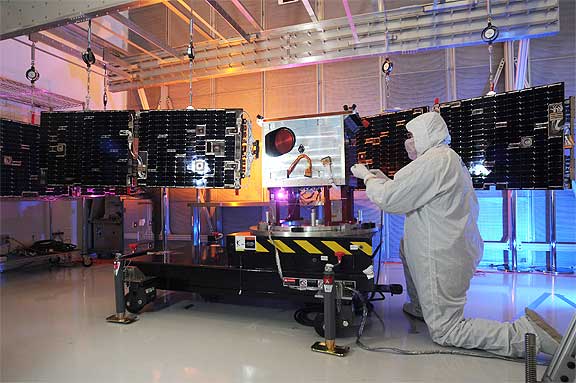...host five payloads and a de-orbit module when it launches in 2013. The STPSat series of satellites successfully proves the concept of a standard interface vehicle for the U.S. Air Force Space and Missile Systems Center, Space Development & Test Directorate (SMC/SD). The STPSat-3 spacecraft is able to support a variety of experimental and risk reduction payloads at different low-Earth orbits and is compatible with multiple launch vehicles by using the flight-proven Ball Configurable Platform 100 (BCP-100) standard interface bus.

STPSat-3, photo courtesy of Ball Aerospace
David L. Taylor, president and CEO of Ball Aerospace, said, “Built in only 47 days, the versatility of this common spacecraft will be evidenced once again when five payloads are flown aboard STPSat-3—two more than carried by SPTSat-2 when it launched in 2010." The payloads for STPSat-3 will include:
- iMESA-R (Integrated Miniaturized Electrostatic Analyzer Reflight), a U.S. Air Force Academy mission designed to measure plasma densities and energies
- J-CORE (Joint Component Research), a space phenomenology mission sponsored by the Air Force Research Laboratory (AFRL) /EO Countermeasures Technology Branch (RYMW) & Army Space and Missile Defense Command (SMDC)
- SSU (Strip Sensor Unit), an AFRL Directed Energy (RD) experiment to provide risk reduction through on-orbit testing and operation of a sensor assembly
- SWATS (Small Wind and Temperature Spectrometer), a Naval Research Laboratory (NRL) mission to provide in-situ measurements of the neutral and plasma environment to characterize the Earth’s ionosphere and thermosphere
- TCTE (TSI Calibration Transfer Experiment) , a NASA/NOAA mission to collect high accuracy, high precision measurements of Total Solar Irradiance to monitor changes in solar irradiance incident at the top the Earth’s atmosphere with TCTE instrument provided by the Laboratory for Atmospheric and Space Physics

